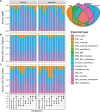iPSCs and iPSC-derived cells as a model of human genetic and epigenetic variation
- PMID: 39966349
- PMCID: PMC11836351
- DOI: 10.1038/s41467-025-56569-4
iPSCs and iPSC-derived cells as a model of human genetic and epigenetic variation
Abstract
Understanding the interaction between genetic and epigenetic variation remains a challenge due to confounding environmental factors. We propose that human induced Pluripotent Stem Cells (iPSCs) are an excellent model to study the relationship between genetic and epigenetic variation while controlling for environmental factors. In this study, we have created a comprehensive resource of high-quality genomic, epigenomic, and transcriptomic data from iPSC lines and three iPSC-derived cell types (neural stem cell (NSC), motor neuron, monocyte) from three healthy donors. We find that epigenetic variation is most strongly associated with genetic variation at the iPSC stage, and that relationship weakens as epigenetic variation increases in differentiated cells. Additionally, cell type is a stronger source of epigenetic variation than genetic variation. Further, we elucidate a utility of studying epigenetic variation in iPSCs and their derivatives for identifying important loci for GWAS studies and the cell types in which they may be acting.
© 2025. The Author(s).
Conflict of interest statement
Competing interests: The authors declare no competing interests.
Figures





References
-
- Gibney, E. R. & Nolan, C. M. Epigenetics and gene expression. Heredity105, 4–13 (2010). - PubMed
MeSH terms
Grants and funding
- U41 HG010972/HG/NHGRI NIH HHS/United States
- U24HG012070/U.S. Department of Health & Human Services | NIH | National Human Genome Research Institute (NHGRI)
- U41HG010972/U.S. Department of Health & Human Services | NIH | National Human Genome Research Institute (NHGRI)
- R35HG011922/U.S. Department of Health & Human Services | NIH | National Human Genome Research Institute (NHGRI)
- T32 HG000045/HG/NHGRI NIH HHS/United States
- R35 HG011922/HG/NHGRI NIH HHS/United States
- U24 HG012070/HG/NHGRI NIH HHS/United States
- R01 HG007175/HG/NHGRI NIH HHS/United States
- T32HG000045-18/U.S. Department of Health & Human Services | NIH | National Human Genome Research Institute (NHGRI)
- R01HG007175/U.S. Department of Health & Human Services | NIH | National Human Genome Research Institute (NHGRI)
LinkOut - more resources
Full Text Sources

